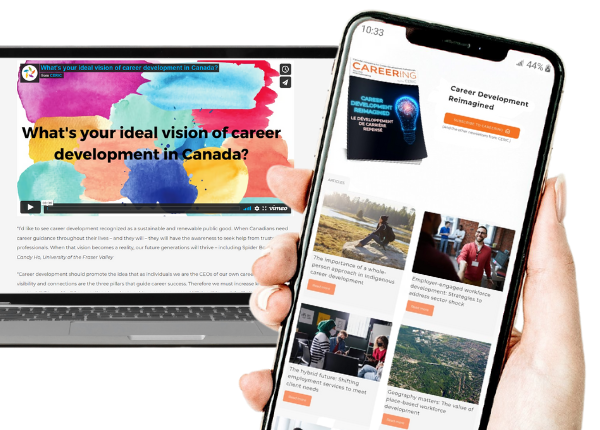
Employer-engaged workforce development: Strategies to address sector shock
October 6, 2021
Fall issue of Careering magazine reimagines career development in Canada
October 6, 2021Indigenous career practitioners integrate cultural world view of interconnectedness to support clients in wide-ranging ways
Tina-Marie Christian, Seanna Quressette and Kevin Ned

For some, the memory of that discussion has long since faded. What you may not have realized then was that these conversations shaped your world view of education and employment. For Indigenous people, these conversations were very different.
Career development from an Indigenous perspective is both similar to and qualitatively different from career development in non-Indigenous settings. There is important historical context that influences the educational and employment experience for some Indigenous individuals and there are current lived experiences that also influence the career paths of Indigenous workers.
The idea of a cookie-cutter approach to career counselling is outdated. Today’s employment counselling practices are much more focused on the needs of the individual – a person-centred approach. This is particularly true for the Indigenous jobseeking client. Before we look too deeply into the current and future opportunities for Indigenous people, we need to stop to consider the source of knowledge and life experiences that shape their choices.
The traumatic legacy of residential schools
The recent news of unmarked graves of children being found at the sites of former Canadian Indian residential schools is being felt across Indigenous communities. Residential school survivors and their children and grandchildren are re-experiencing the trauma of the residential school experience.
In 1996, a report by the Royal Commission on Aboriginal Peoples exposed the trauma and abuse suffered by several generations of Indigenous people who were forced to attend residential schools. These institutions purported to educate and acculturate Indigenous students; that was not what happened. Education was several rungs below religious indoctrination, domestic and field labour, and life lessons of servitude. The actual learning experience and any scholarly accomplishments were abysmal.
For many children of residential school survivors, school stopped at the mandated age of 16. It wasn’t easy to attend post-secondary education because there was no family support or interest from family members to pursue this education. There was little family value placed on participation in the Canadian school system. To compound matters, the patriarchal system of the Department of Indian Affairs presented many roadblocks to post-secondary pursuits. As noted in the 2009 book A Short History of Aboriginal Education in Canada: “Needless to say, few students progressed past the primary grades regardless of how many years were spent in school. In 1930, only 3% of Indigenous students had progressed past grade 6 and three-quarters of all those in school were in grades 1 to 3.”

A woman and her two young children leave flowers at the site of the former Kamloops Indian Residential School, where the remains of 215 children were found buried earlier this year. (iStock)
This kept many Indigenous people out of the labour market. Some Elders believe that this was by design, as laws also prohibited entrepreneurial and employment efforts by restricting mobility and preventing access to capital. Indian agents employed by the federal Department of Indian Affairs had to provide passes to leave the reserve, which of course limited access to the job market.
When Indigenous students did make it to post-secondary education, they were often ill-prepared academically and found that the teaching methods did not align with their ways of learning and knowing. The inter-generational trauma and impact of residential schools continues to affect today’s jobseekers and students. Many children of residential school survivors have experienced mental health challenges including anxiety and addictions as they move through post-secondary education.
Building a better future in education
The natural progression of learning through discovery and perpetual advancement that Canadians experienced was vastly different than the prescribed autocratic and paternalistic Indian Affairs approach. Colonization jumped over the whole process of development that Canadians experienced through the Industrial Revolution. Indigenous people went from traditional land-based learning and teaching styles to that of a highly structured classroom approach that didn’t factor in experiential learning.
“For many Indigenous students, learning is best done in a relational, experiential and visual context.”
Despite the challenges they have faced, Indigenous leaders and their communities have held the course for self-governance and self-reliance. Formal political lobbying started as far back as 1972, with the National Indian Brotherhood’s Indian Control of Indian Education policy paper that spearheaded changes to the education system for Indigenous people.
As educational institutions begin to understand the challenges some Indigenous students face, they are adopting more inclusive ways of learning with the support of Elders, Indigenous advocates and Indigenous Learning Centres. For many Indigenous students, learning is best done in a relational, experiential and visual context. In an Indigenous integrated world view, learning includes the heart, the mind and the body. Indigenous ways of knowing include providing context for why the learning is taking place, understanding the relationships being built through the learning, and using images and real-life examples in teaching.
In March 2021, the Conference Board of Canada reported there are currently 80+ national Indigenous institutions that serve over 10,000 students a year. This represents an increase of 15% in 15 years. It will be through these institutions that we begin to see significant changes in Indigenous students’ post-secondary participation and graduation rates.
A 2018 Assembly of First Nation fact sheet on Indigenous education revealed that nearly half (47%) of Indigenous post-secondary graduates have completed a college diploma. Some of the challenges Indigenous students continue to face include lack of confidence/preparedness, not a personal priority, cost, personal/family responsibilities and personal health.
Read more on supporting Indigenous career development
16 resources to help settlers understand and advance Indigenous reconciliation
Allyship in career development: An honour, privilege and responsibility
Trina Maher: ‘Our communities are so rich in terms of resources and creativity’
Connecting to the labour market
We also know that Indigenous people may face other challenges to pursuing employment. Low literacy, for instance, is a barrier to employment rooted in intergenerational trauma and colonial history. Other practical considerations such as limited access to daycare and transportation and lack of a driver’s licence are due in part to living in remote locations. Cultural differences, communication skills, social mores and negative stereotypes also affect Indigenous jobseekers’ employment opportunities.
These stereotypes include the skewed image most non-Indigenous people have of reserves. Many think of the poverty and lack of opportunity. They don’t see the economic development in many communities and the existence of wrap-around services for community members including education, employment, health, mental health and social development.
These services play an important role in supporting Indigenous students and jobseekers – and may be in higher demand going forward, with the Indigenous labour force growing three to five times faster than the labour force as a whole. Youth supports may be especially needed, with approximately half of the Indigenous population under 25.
The role of Indigenous career practitioners
Fortunately, today, there are many robust training programs – on and off-reserve – to assist Indigenous jobseekers to access employment opportunities. These training programs include vocational training and academic training.
Importantly, services often do not stop at career counselling. In keeping with the cultural world view of interconnectedness, Indigenous career counsellors are often tasked with supporting their clients in wide-ranging ways, from referrals to counselling or addiction services, to client data management, to providing intake interviews and working on resumes, as well as assisting workers to communicate with employers.
It is this whole-world, whole-person view that makes the Indigenous CDP invaluable. A federally funded program under the Employment Skills and Development Canada (ESDC), Indigenous Skills Employment Training (ISET) is designed to help Indigenous people find improve their skills and find employment.
ISET provides funding to Indigenous Service delivery organizations that design and deliver job training services to First Nations, Inuit, Metis and urban/non-affiliated Indigenous people in their commities.
Resources for career practitioners to support Indigenous clients:
- Indigenous Works and Indigenous Corporate Training provide support to both industry and jobseekers, with training on how to work with Indigenous communities and recruiting opportunities for Indigenous people.
- The website Indian Horse lists many initiatives by Indigenous-run businesses that encourage employment and mentorship within Indigenous communities.
- Douglas College offers the Career Development Practice Certificate Program, which consists of 10 courses plus optional courses such as ACDP 500: Aboriginal Employment Issues.
The program also provides career path training and certification for Indigenous career development counsellors (certified career development practitioners).
One of the great things about the ISET program is that Indigenous jobseekers sometimes experience a sense of comfort working with another Indigenous member. These Indigenous CDPs are knowledgeable about protocols, they are not shocked by family histories and are able to connect with individuals at all stages of their career journey.
Also, Indigenous career practitioners act as role models for folks entering or re-entering the workforce. They see the Indigenous career counsellor as someone from their community who completed training and is now there to offer services.
Indigenous career practitioners also play an important role in educating employers about how to work with Indigenous employees, as well as helping industry learn about Indigenous culture and history and protocols that affect employment.
We’ve heard many success stories from Indigenous graduates of the Douglas College Career Practitioner program that remind us of the important work yet to be done on the road to reconciliation. That road starts with remembering … and then we can create a new vision.
Tina-Marie Christian, MAOM, BEd is from the Syilx Nation (Okanagan) and a member of the Splatsin First Nation (Enderby, BC). She holds a Master of Arts Degree in Organizational Management, a Bachelor of (Adult) Education and an Associate Business Administration degree (Marketing). She has over 40 years of experience working for Aboriginal organizations in education and staff development, advocacy, community and personal development, and health and wellness. Christian teaches the Aboriginal Career Development Course at Douglas College.
Seanna Quressette, MEd, CCDP has 30+ years’ experience in career development and has taught Indigenous career practitioners for over 20 years. Quressette is the Co-ordinator of Continuing Education in the Faculty of Applied Community Studies at Douglas College.
Kevin Ned is a member of the Upper Nicola Band and is the Employment Training Facilitator for Westbank First Nation. Ned has been involved in training and employment for over 20 years, including 14 years as the Education Director for the Okanagan Indian Band. He also served for 12 years as an elected band councillor for his band, and has a business diploma from Nicola Valley Institute of Technology, a Career Development Practitioner Certificate and Essential Skills Certificate from Douglas College.

